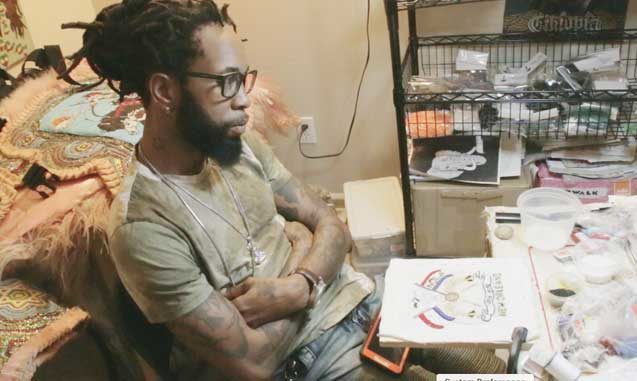
Timeline:
Present – 2013 – Big Chief Demond Young Seminole Hunters
2013 – 1994 – Spy Boy – Seminoles
As a young chief, Big Chief Demond is a strong, well read, humble, student of Black Masking Culture and confident contemporary artist that embodies the spirit of “Bras Coupe.” Sitting down with Chief Demond, it is obvious the strength in his leadership comes from his knowledge of this culture and years working up the hierarchy. As he says, no one beat him as a Spy Boy.
“I was the Spy Boy of the Nation!” Chief summons the spirit of Bras-Coupe (enslaved African Prince given name “Squire”) as his inspiration in Black Masking Culture. Most familiar with this culture is familiar with the Charles Deslondes and the 1811 Slave Revolt. Little know there were many revolts and many small bands (gangs) that were heroes to slaves and later became folklore. Bras-Coupe was written about mostly by George Washington Cable but his actions are acted out in much of the Black Masking Culture today says Big Chief Demond. More importantly for Chief is that Bras-Coupe was reported to be an African Prince standing 6’7 who eventually wore Indian headdress rafting down the Mississippi after raiding plantations and the City.
The Original Seminole Black Masking Tribe pays homage to the Seminole Freedman (freed Black slaves) that joined the Seminole Indians (aboriginals) fighting the Indian vs United States battles and revolts. The young Seminoles follow the same mandate but incorporates todays’ concerns (economics) by having his tribe utilize there sewing skills and artistic designs into contemporary art. As Chief says when we sewing our suits that’s sacred, but outside of that we work!
Q) What is the spirit of your Gang?
A) Cultural, deep studying to bring some real deep historical pieces to the street and teaching the youth. Sewing keeping the culture going, you know culture bearing. Really sewing to the bone, doing what our elders did and bringing back to that. That’s what my gang is supposed to do, just bring that old school back and letting be known we all bout about that needle and thread.
Q) From your perspective Chief, what does this culture pay homage too?
A) I’ve heard stories of the slaves running to the Indian reservations for refuge and it had to happen that way. But I’ve studied and heard from elder chiefs and man…. studies of Africa, I studied rebellious slaves. Bras Coupe was an African Prince that could not be sold at Congo Square. The Slaves watched that! He came with a distinctive dance, the bamboula and nobody knew that dance and he was beast with it. His stature trickle down, he started doing different things, they locked him up. Sent him to Pointe Coupee Parish, Louisiana. He broke loose, he killed slave masters and did different things like that. Knowing that they stole his wife, they locked up his wife. So, he came back for his wife. She was creole she was light skinned, so he did a few rebellious things to the slave masters but he was a hero to the slaves. He shot, couldn’t be killed, shot different times, cut arm, cut his ear off, took his ligaments and he still lived until a fisherman ratted (bludgeoned to death) him out for 2000 dollars (according to historical records it was Francisco Garcia former ally that settled for 200 plus dollars with the City of New Orleans in 1837).
Q) Who inspired you in this culture as a youth?
A) Big Chief Tootie Montana (Yellow Pocahontas, Big Chief Joe Pete (Seminole) and Keitoe (Seminoles) and many others.
Q) What’s your tribe’s mission?
A) Get away from New Orleans and show the world our craft. I try to show my fellow Indians…man we are artist. What we do should be magnified. So, my mission is to keep this culture going another 300 years. Yeah, we mask for the City 300 years we brought culture to the City 300 years we been pumpin it 300 years…the City ain’t gave nothing back. The nation did not sit down when they come together and got at them. So that’s the mission for the nation for the Indians in this City. They gotta come together, all of us, uptown, downtown gotta come together if we come collectively and get at them people in the City. We are quoted in every proposal. “Oh, we gotta put them in the plan, oh they together?” “All Nations”? All tribes will come to City Hall…. If we do that, and show them we together, not just no uptown Indian Council, downtown. No, it’s a one council and we all together. Yeah, a one nation.
Q) Chief some believe the biggest secret of this culture, is how much money is being made outside the culture on the culture?
A) If you out there than you can tap into that, then you can find out who stealing! Than we find out and expose it. I one of those people that expose it all. Some hate me for that, I am who I am. I expose it, imma youngster and imma Elder youngster cause I’m just fastened and molded. I’ve been here since the 90’s. All the elders that are gone, I sat with them. I sewed with them, conversed with them got with a lot of them and they all gave me pointers and advice but the first elder to put a needle and thread with beads was Ferdinand Bigard.
Q) What is your advice for the youth coming into this culture?
A) Learning this culture, studying this culture, learning how to sew is paramount in this culture. When you come into a tribe you have to respect and honor your Chief. Hold him high and learn your positions. When you out there on the streets its Indians Games but it’s Not! It’s an honor to wear Feathers!
Recommended For You.



Be the first to comment